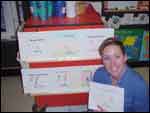Overview How can classrooms be bully free? When everyone in the school community agrees to a no-tolerance policy. Buddy reading with older students relays how to deal with hurtful teasing and bullying. Youngsters write books about their own experiences and display them during open house and schoolwide events. Role-play reinforces social skills: how to apologize, how to comfort victims, and how to make friends. Classroom pledges, posters and bookmarks advertise no room for bullies. When children discover that together they have the power to make positive changes in their school community, behavior improves and bullies can become friends.
|
Classroom
Activities
|
Community
Activities
|
Career
Activities
|
||||||||||||||||||||||||||||||||||||||||||||||||||||||
|
|
|
|
Learning Standards Health |
|
| • | Describe characteristics of inclusive and supportive social environments (family, friends, school, etc.). |
| • | Identify behaviors and situations that are risky and harmful to self and others. |
| • | Use communication and problem-solving skills to set personal boundaries, resolve conflicts, and develop positive relationships. |
| • | Identify and practice communication skills. |
|
Learning Standards Social Studies |
|
| • | Learn that school is a community in which students are equals, and that all must be considerate of others for the school to be a good place to play, work, and learn. |
| • | Learn appropriate classroom conduct, such as sharing, taking turns (and related habits that implicitly involve treating others as equals, irrespective of individual differences). |
| • | Learn that students must live up to school expectations of its citizens. |
|
Learning Standards English Language Arts |
|
| • | Contribute knowledge to class discussions to develop framework for class project. |
| • | Read student created books to other students using proper pace, volume, and clear enunciation. |
| • | Identify basic facts and essential ideas in what students have read, heard, or viewed. |
| • | Identify, analyze, and apply knowledge of theme in literature and provide evidence from the text to support understandings. |
| • | Write a book about personal experiences with clear focus and adequate details. |
| • | Use art to express ideas, beliefs, and emotions. |
| • | Generate relevant questions to be used in gathering information from others. |
|
School to Career Competencies |
|
| • | Manage Stress and Conflict. |
| • | Develop Communication and Literacy Skills. |
| • | Use Technology. |
| • | Solve Problems. |
| • | Take Responsibility For Life Choices. |
Assessment Students are assessed and receive feedback on process and products of their book, poster & bookmark making during Writers Workshop peer and teacher editing. Students' circle time interviews and discussions are evaluated through teacher observation checklist
Software or Materials Used For books, posters, bookmarks: Microsoft Word, KidPix, bookbinder, laminator, paper, washable markers, flair felt-tip pens, glue sticks. For literature on bullying, see list.
Web Sites See Befriending Bullies Web Sites.
Keywords Befriending Bullies, Bookmaking, Bullies, School to Career, Service Learning, Teasing, Writers Workshop
Final Words Learning how to be a friend is one of the most important behaviors teachers can model for students. When a child hurts another child, s/he needs to know how to say, "I am sorry for__________." and then how to ask, "Are you OK?" I found that my students have become more caring and considerate to others. They are learning how to be positive role models for members of the school and home community.
Teacher Tip Start every day with a smile and really listen.

E-mail contact Jennifer Shammas jshammas@boston.k12.ma.us
Teacher Bio Jennifer Shammas is a first grade teacher at the Josiah Quincy Elementary School. She has been teaching for two years and is a member of the School Site Council. Graduating Magna cum Laude from the University of Massachusetts Boston with a degree in psychology and a certificate in elementary education, Jennifer is also a member of the National Psi Chi Honor Society. She is currently enrolled in a Masters Degree program at Fitchburg State College.
Subject Areas Health, Social Studies, English Language Arts
Grade Levels 1 - 5
Students Inclusive
